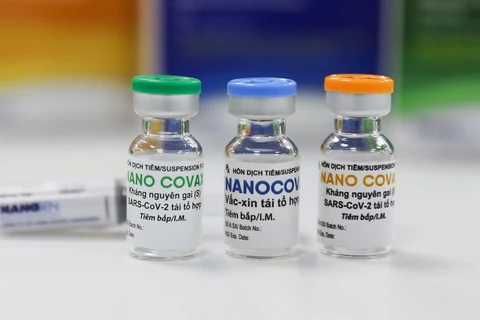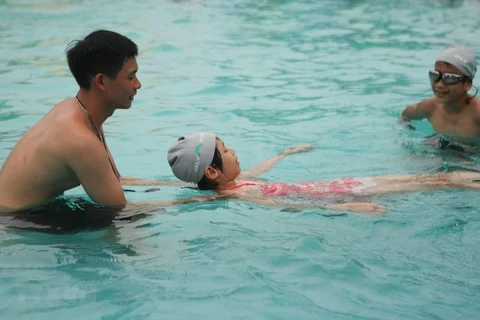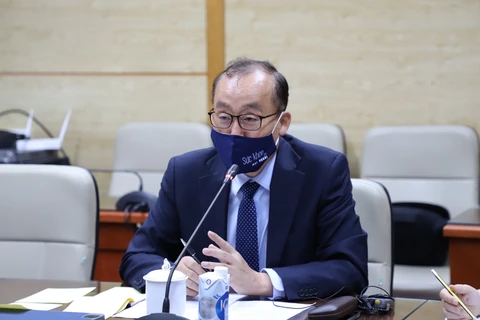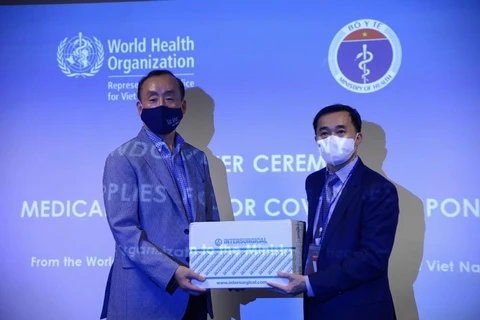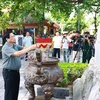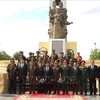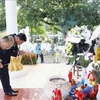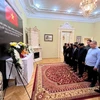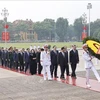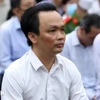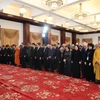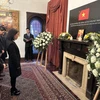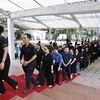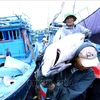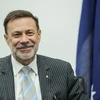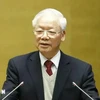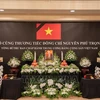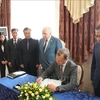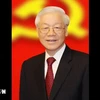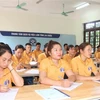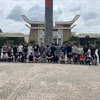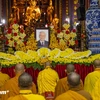Hanoi (VNA) – Dr Kidong Park, Representative of the World Health Organisation (WHO) in Vietnam, has highlighted the Vietnamese Government’s measures and efforts to fight the COVID-19 pandemic.
“The whole-of-society approach is led by the highest level of the Government, with the Prime Minister now heading the National Steering Committee for COVID-19 prevention and control. This demonstrates the strong determination of the Government to combat the outbreak situation,” Park said in an inclusive interview granted to the Vietnam News Agency (VNA) on September 10.
Following is the full text of the interview.
What are the WHO’s opinion of safely living with the COVID-19 pandemic? What are the specific steps Vietnam should take to safely adapt to life amid the pandemic?
The world has been fighting this pandemic profusely in the past 20 months. In Vietnam, our early and strong action in 2020 kept in virus at bay. However, we have been facing the most challenging phase of the pandemic in the last four and half months. Vietnam has been taking a whole-of-society approach to limit transmission and save people’s lives.
It now seems clear that globally, the virus will not disappear – at least not in the near future. The virus will continue to spread and endanger people’s lives. It will also have both short- and long-term financial consequences.
At the same time, we have gained more knowledge on the virus – its characteristics and who are at higher risk of severe disease. We also have effective tools to fight the virus – 5K and vaccine.
With this in mind, WHO can see some scenarios for the future.
The first scenario is where our actions allow us to live with the virus, also called the NEW NORMAL.
We reduce the risk it poses by making the best use of vaccination and other prevention measures, and respond with short, targeted measures.
This does not mean giving up on controlling the virus. We focus on trying to limit spread, protecting the most vulnerable, and in doing so, reduce the health and broader social impacts of outbreaks.
The second scenario is where more dangerous variants are able to evolve – variants that spread even more easily, cause more severe disease, or are resistant to existing vaccines.
This scenario – and all of the associated health, social and economic costs – is the one we wanted to avoid if possible.
Which of these two scenarios becomes reality depends on which individual and collective actions we choose to take in the weeks and months ahead. So it is in our power to shape the course that the pandemic takes next.
The Government may consider the followings to shape the future scenario of this pandemic toward more favorable one:
First, getting priority populations, especially health workers, older people, those with co-morbidities and then whole communities, vaccinated as quickly as possible is crucial.
Second, give more priorities of vaccination to areas with relatively weaker health system and fragile settings.
Third, continue to strictly practice 5K measures at home, school, workplace etc., with the personal protective behaviors and public health measures that reduce transmission even some social distancing measures are relaxed.
Fourth, further strengthen health system capacity to better manage serious COVID-19 patients while introducing appropriate right care pathway model to avoid overloading of hospitals with mild and moderate cases.
Using these tools in combination is the key to limiting spread, and the virus’ ability to mutate into more dangerous variants.
The Government, and with support from the people, can work hand in hand to do all we can to avoid the second future scenario.
What is WHO’s assessment about Vietnam’s home-grown COVID-19 vaccine and medicine?
I am aware that a few COVID-19 vaccine candidates are being developed by manufacturers in Vietnam. Some are already at clinical trial phases.
WHO has supported Vietnam in strengthening the capacity of national regulatory authority of vaccine and medicine, the NRA. The NRA Vietnam has been certified as the Maturity Level 3 by WHO in 2020 which is the second highest level in WHO assessment scheme of NRA. It means that the NRA in Vietnam is capable to guide vaccine manufactures and evaluate the efficacy, safety and quality of vaccine candidates.
I would remind you that the development of new vaccine is very challenging task. Sometimes, it fails.
The best way to support the vaccine research and development in county is to let the NRA and the developer do it scientific way and do not skip any essential step to ensure efficacy, safety and quality of vaccines under development.
WHO’s evaluation on the country’s COVID-19 prevention and control measures in the past time? What should Vietnam do in the time to come.
Vietnam is still in a very complicated and difficult outbreak situation, with number of cases crossing more than half million since beginning of September. We continue to report high numbers of daily recorded cases and deaths over the past weeks, mainly from Ho Chi Minh City and neighboring provinces. This trend is concerning as it indicates a very high risk of onwards community transmission.
Health care facilities in outbreak provinces are overstretched, health care system is under a huge pressure and health care workers are overwhelmed.
The Government of Vietnam has been tirelessly implementing measures, making tremendous efforts and mobilising resources to fight this pandemic, especially to support hotspot provinces. We have seen human resources and technical experts sent for surge support to provinces that needed additional capacities.
The whole-of-society approach is led by the highest level of the Government, with the Prime Minister now heading the National Steering Committee for COVID-19 prevention and control. This demonstrates the strong determination of the Government to combat the outbreak situation.
There is still a lot of tasks ahead to overcome and the next few weeks will be critical. WHO remains confident that Vietnam’s robust public health emergency response is on the right track in managing the current outbreaks./.
“The whole-of-society approach is led by the highest level of the Government, with the Prime Minister now heading the National Steering Committee for COVID-19 prevention and control. This demonstrates the strong determination of the Government to combat the outbreak situation,” Park said in an inclusive interview granted to the Vietnam News Agency (VNA) on September 10.
Following is the full text of the interview.
What are the WHO’s opinion of safely living with the COVID-19 pandemic? What are the specific steps Vietnam should take to safely adapt to life amid the pandemic?
The world has been fighting this pandemic profusely in the past 20 months. In Vietnam, our early and strong action in 2020 kept in virus at bay. However, we have been facing the most challenging phase of the pandemic in the last four and half months. Vietnam has been taking a whole-of-society approach to limit transmission and save people’s lives.
It now seems clear that globally, the virus will not disappear – at least not in the near future. The virus will continue to spread and endanger people’s lives. It will also have both short- and long-term financial consequences.
At the same time, we have gained more knowledge on the virus – its characteristics and who are at higher risk of severe disease. We also have effective tools to fight the virus – 5K and vaccine.
With this in mind, WHO can see some scenarios for the future.
The first scenario is where our actions allow us to live with the virus, also called the NEW NORMAL.
We reduce the risk it poses by making the best use of vaccination and other prevention measures, and respond with short, targeted measures.
This does not mean giving up on controlling the virus. We focus on trying to limit spread, protecting the most vulnerable, and in doing so, reduce the health and broader social impacts of outbreaks.
The second scenario is where more dangerous variants are able to evolve – variants that spread even more easily, cause more severe disease, or are resistant to existing vaccines.
This scenario – and all of the associated health, social and economic costs – is the one we wanted to avoid if possible.
Which of these two scenarios becomes reality depends on which individual and collective actions we choose to take in the weeks and months ahead. So it is in our power to shape the course that the pandemic takes next.
The Government may consider the followings to shape the future scenario of this pandemic toward more favorable one:
First, getting priority populations, especially health workers, older people, those with co-morbidities and then whole communities, vaccinated as quickly as possible is crucial.
Second, give more priorities of vaccination to areas with relatively weaker health system and fragile settings.
Third, continue to strictly practice 5K measures at home, school, workplace etc., with the personal protective behaviors and public health measures that reduce transmission even some social distancing measures are relaxed.
Fourth, further strengthen health system capacity to better manage serious COVID-19 patients while introducing appropriate right care pathway model to avoid overloading of hospitals with mild and moderate cases.
Using these tools in combination is the key to limiting spread, and the virus’ ability to mutate into more dangerous variants.
The Government, and with support from the people, can work hand in hand to do all we can to avoid the second future scenario.
What is WHO’s assessment about Vietnam’s home-grown COVID-19 vaccine and medicine?
I am aware that a few COVID-19 vaccine candidates are being developed by manufacturers in Vietnam. Some are already at clinical trial phases.
WHO has supported Vietnam in strengthening the capacity of national regulatory authority of vaccine and medicine, the NRA. The NRA Vietnam has been certified as the Maturity Level 3 by WHO in 2020 which is the second highest level in WHO assessment scheme of NRA. It means that the NRA in Vietnam is capable to guide vaccine manufactures and evaluate the efficacy, safety and quality of vaccine candidates.
I would remind you that the development of new vaccine is very challenging task. Sometimes, it fails.
The best way to support the vaccine research and development in county is to let the NRA and the developer do it scientific way and do not skip any essential step to ensure efficacy, safety and quality of vaccines under development.
WHO’s evaluation on the country’s COVID-19 prevention and control measures in the past time? What should Vietnam do in the time to come.
Vietnam is still in a very complicated and difficult outbreak situation, with number of cases crossing more than half million since beginning of September. We continue to report high numbers of daily recorded cases and deaths over the past weeks, mainly from Ho Chi Minh City and neighboring provinces. This trend is concerning as it indicates a very high risk of onwards community transmission.
Health care facilities in outbreak provinces are overstretched, health care system is under a huge pressure and health care workers are overwhelmed.
The Government of Vietnam has been tirelessly implementing measures, making tremendous efforts and mobilising resources to fight this pandemic, especially to support hotspot provinces. We have seen human resources and technical experts sent for surge support to provinces that needed additional capacities.
The whole-of-society approach is led by the highest level of the Government, with the Prime Minister now heading the National Steering Committee for COVID-19 prevention and control. This demonstrates the strong determination of the Government to combat the outbreak situation.
There is still a lot of tasks ahead to overcome and the next few weeks will be critical. WHO remains confident that Vietnam’s robust public health emergency response is on the right track in managing the current outbreaks./.
VNA

